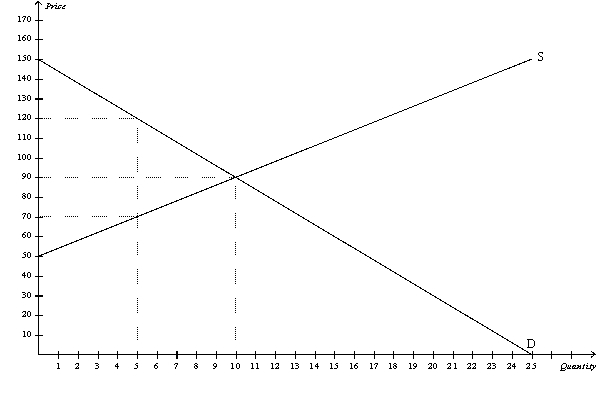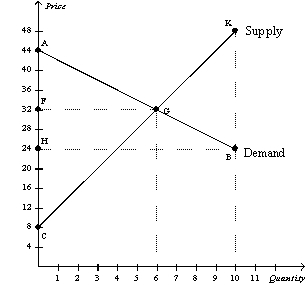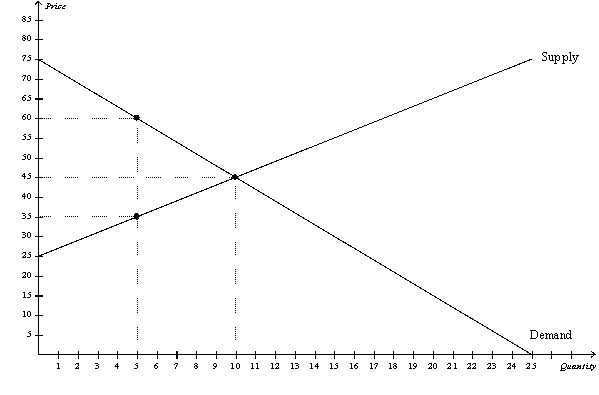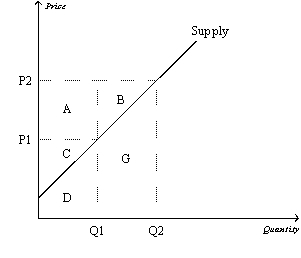A) $700
B) $2,300
C) $3,000
D) $3,700
Correct Answer

verified
Correct Answer
verified
Multiple Choice
Suppose televisions are a normal good and buyers of televisions experience a decrease in income.As a result,consumer surplus in the television market
A) decreases.
B) is unchanged.
C) increases.
D) may increase, decrease, or remain unchanged.
Correct Answer

verified
Correct Answer
verified
Multiple Choice
If the current allocation of resources in the market for hammers is inefficient,then it must be the case that
A) producer surplus exceeds consumer surplus in the market for hammers.
B) consumer surplus exceeds producer surplus in the market for hammers.
C) the sum of consumer surplus and producer surplus could be increased by moving to a different allocation of resources.
D) the costs that sellers of hammers are incurring could be reduced by moving to a different allocation of resources.
Correct Answer

verified
Correct Answer
verified
Multiple Choice
Table 7-6
 -Refer to Table 7-6.You have four essentially identical extra tickets to the Midwest Regional Sweet 16 game in the men's NCAA basketball tournament.The table shows the willingness to pay of the four potential buyers in the market for a ticket to the game.You offer to sell the tickets for $325.How many tickets do you sell,and what is the total consumer surplus in the market?
-Refer to Table 7-6.You have four essentially identical extra tickets to the Midwest Regional Sweet 16 game in the men's NCAA basketball tournament.The table shows the willingness to pay of the four potential buyers in the market for a ticket to the game.You offer to sell the tickets for $325.How many tickets do you sell,and what is the total consumer surplus in the market?
A) one ticket; $175
B) two tickets; $225
C) three tickets; $225
D) three tickets; $275
Correct Answer

verified
Correct Answer
verified
Multiple Choice
Table 7-10
 -Refer to Table 7-10.You want to hire a professional photographer to take pictures of your family.The table shows the costs of the four potential sellers in the local photography market.You hire Kevin for a price of $500.What is his producer surplus?
-Refer to Table 7-10.You want to hire a professional photographer to take pictures of your family.The table shows the costs of the four potential sellers in the local photography market.You hire Kevin for a price of $500.What is his producer surplus?
A) $500
B) $150
C) $100
D) $50
Correct Answer

verified
Correct Answer
verified
Multiple Choice
Consumer surplus
A) is the amount of a good that a consumer can buy at a price below equilibrium price.
B) is the amount a consumer is willing to pay minus the amount the consumer actually pays.
C) is the number of consumers who are excluded from a market because of scarcity.
D) measures how much a seller values a good.
Correct Answer

verified
Correct Answer
verified
Multiple Choice
Suppose consumer income increases.If grass seed is a normal good,the equilibrium price of grass seed will
A) decrease, and producer surplus in the industry will decrease.
B) increase, and producer surplus in the industry will increase.
C) decrease, and producer surplus in the industry will increase.
D) increase, and producer surplus in the industry will decrease.
Correct Answer

verified
Correct Answer
verified
True/False
Consumer surplus can be measured as the area between the demand curve and the supply curve.
Correct Answer

verified
Correct Answer
verified
Multiple Choice
Figure 7-11
 -Refer to Figure 7-11.If the government imposes a price ceiling of $70 in this market,then the new producer surplus will be
-Refer to Figure 7-11.If the government imposes a price ceiling of $70 in this market,then the new producer surplus will be
A) $50.
B) $100.
C) $175.
D) $350.
Correct Answer

verified
Correct Answer
verified
Multiple Choice
Table 7-1
 -Refer to Table 7-1.If the price of the product is $15,then who would be willing to purchase the product?
-Refer to Table 7-1.If the price of the product is $15,then who would be willing to purchase the product?
A) Lori
B) Lori and Audrey
C) Lori, Audrey, and Zach
D) Lori, Audrey, Zach, and Calvin
Correct Answer

verified
Correct Answer
verified
Multiple Choice
If the cost of producing sofas decreases,then consumer surplus in the sofa market will
A) increase.
B) decrease.
C) remain constant.
D) increase for some buyers and decrease for other buyers.
Correct Answer

verified
Correct Answer
verified
Multiple Choice
Figure 7-20
 -Refer to Figure 7-20.At equilibrium,consumer surplus is measured by the area
-Refer to Figure 7-20.At equilibrium,consumer surplus is measured by the area
A) ACG.
B) AFG.
C) KBG.
D) CFG.
Correct Answer

verified
Correct Answer
verified
Multiple Choice
Figure 7-15
 -Refer to Figure 7-15.At the equilibrium price,consumer surplus is
-Refer to Figure 7-15.At the equilibrium price,consumer surplus is
A) $150.
B) $200.
C) $250.
D) $350.
Correct Answer

verified
Correct Answer
verified
Multiple Choice
If a consumer is willing and able to pay $20 for a particular good and if he pays $16 for the good,then for that consumer,consumer surplus amounts to
A) $4.
B) $16.
C) $20.
D) $36.
Correct Answer

verified
Correct Answer
verified
Multiple Choice
Which of the following is correct?
A) Efficiency deals with the size of the economic pie, and equality deals with how fairly the pie is sliced.
B) Equality can be judged on positive grounds whereas efficiency requires normative judgments.
C) Efficiency is more difficult to evaluate than equality.
D) Equality and efficiency are both maximized in a society when total surplus is maximized.
Correct Answer

verified
Correct Answer
verified
Multiple Choice
At Nick's Bakery,the cost to make homemade chocolate cake is $3 per cake.As a result of selling three cakes,Nick experiences a producer surplus in the amount of $19.50.Nick must be selling his cakes for
A) $6.50 each.
B) $7.50 each.
C) $9.50 each.
D) $10.50 each.
Correct Answer

verified
Correct Answer
verified
Multiple Choice
A seller's willingness to sell is
A) measured by the seller's cost of production.
B) related to her supply curve, just as a buyer's willingness to buy is related to his demand curve.
C) less than the price received if producer surplus is a positive number.
D) All of the above are correct.
Correct Answer

verified
Correct Answer
verified
Multiple Choice
Figure 7-12
 -Refer to Figure 7-12.When the price is P2,producer surplus is
-Refer to Figure 7-12.When the price is P2,producer surplus is
A) A.
B) A+C.
C) A+B+C.
D) D+G.
Correct Answer

verified
Correct Answer
verified
Multiple Choice
Table 7-5
For each of three potential buyers of oranges, the table displays the willingness to pay for the first three oranges of the day. Assume Alex, Barb, and Carlos are the only three buyers of oranges, and only three oranges can be supplied per day.
 -Refer to Table 7-5.The market quantity of oranges demanded per day is exactly 5 if the price of an orange,P,satisfies
-Refer to Table 7-5.The market quantity of oranges demanded per day is exactly 5 if the price of an orange,P,satisfies
A) $1.00 < P < $1.50.
B) $0.80 < P < $1.50.
C) $0.80 < P < $1.00.
D) $0.75 < P < $0.80.
Correct Answer

verified
Correct Answer
verified
Multiple Choice
If the price of oak lumber increases,what happens to consumer surplus in the market for oak cabinets?
A) Consumer surplus increases.
B) Consumer surplus decreases.
C) Consumer surplus will not change consumer surplus; only producer surplus changes.
D) Consumer surplus depends on what event led to the increase in the price of oak lumber.
Correct Answer

verified
Correct Answer
verified
Showing 241 - 260 of 460
Related Exams